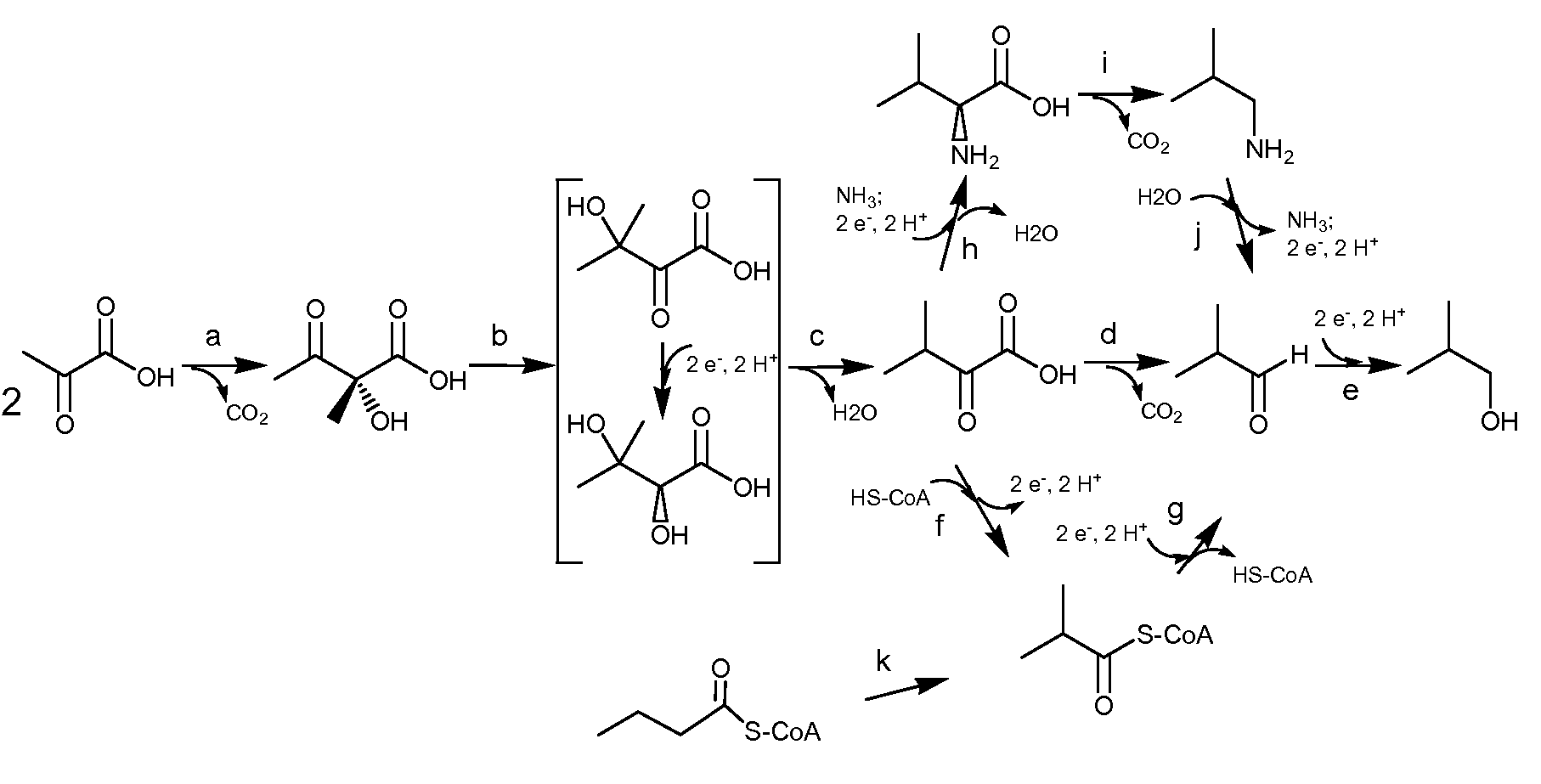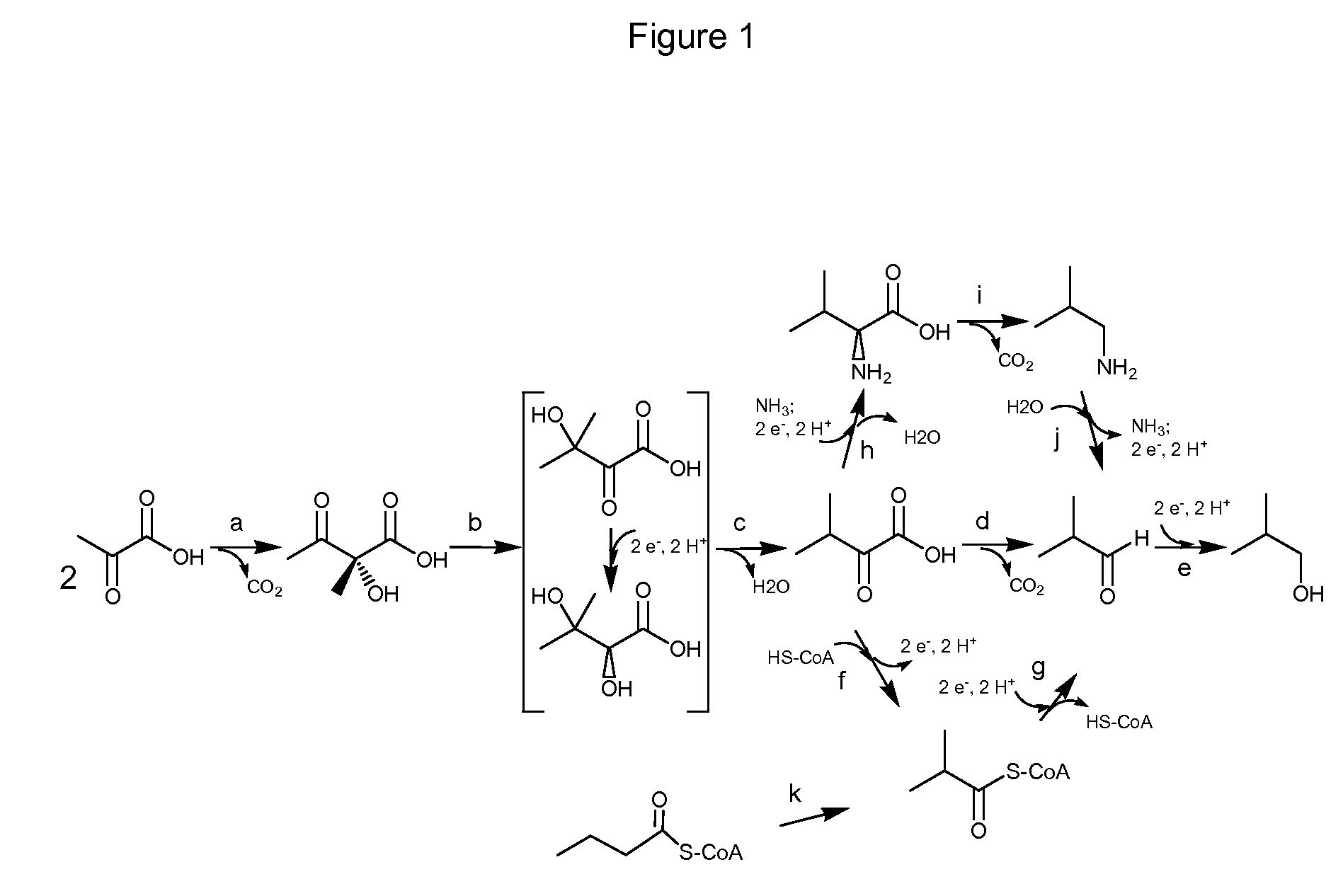Method for the production of isobutanol
a technology of isobutanol and valine, which is applied in the direction of lyase, enzymology, biofuels, etc., can solve the problems of low yield of fusel oil and/or its components during beverage fermentation, and cost prohibitive use of valine as feedstock for industrial scale isobutanol production, etc., to achieve the effect of reducing temperature and more robust tolerance of the production hos
- Summary
- Abstract
- Description
- Claims
- Application Information
AI Technical Summary
Benefits of technology
Problems solved by technology
Method used
Image
Examples
example 1
Increased Tolerance of Lactobacillus plantarum PN0512 to 1-butanol, iso-butanol and 2-butanol at Decreased Growth Temperatures
[0182]Tolerance levels of bacterial strain Lactobacillus plantarum PN0512 (ATCC # PTA-7727) were determined at 25° C., 30° C. and 37° C. as follows. The strain was cultured in S30L medium (i.e., 10 mM ammonium sulfate, 5 mM potassium phosphate buffer, pH 7.0, 50 mM MOPS, pH 7.0, 2 mM MgCl2, 0.7 mM CaCl2, 50 μM MnCl2, 1 μM FeCl3, 1 μM ZnCl2, 1.72 μM CuCl2, 2.53 μM COCl2, 2.42 μM Na2MoO4, 2 μM thiamine hydrochloride, 10 mM glucose, and 0.2% yeast extract). An overnight culture in the absence of any test compound was started in 15 mL of the S30L medium in a 150 mL flask, with incubation at 37° C. in a shaking water bath. The next morning, the overnight culture was diluted into three 500 mL flasks containing 150 mL of fresh medium to an initial OD600 of about 0.08. Each flask was incubated in a shaking water bath, one each at 25° C., 30° C. and 37° C. Each large ...
example 2
Increased Tolerance of Escherichia coli to 1-butanol at Decreased Exposure Temperature
[0184]The effect of growth and exposure temperature on survival of Escherichia coli in the presence of 1-butanol was tested using stationary phase cultures in a rich medium and log phase cultures in a defined medium. For the stationary phase studies, E. coli strain MG1655 (ATCC # 700926) was grown overnight in LB medium (Teknova, Half Moon Bay, Calif.) with shaking at 250 rpm at 42° C., 29° C. or 28° C. Survival of 1-butanol shock was tested at exposure temperatures of 0° C., 28° C. or 42° C. The 1-butanol exposure at 28° C. or 42° C. was started immediately after removing the overnight cultures from the growth incubators. The 1-butanol exposure at 0° C. was done after allowing the overnight cultures to cool on ice for about 15 min. A series of solutions of 1-butanol at different concentrations in LB medium was made and 90 μL aliquots were put in microfuge tubes. To these were added 10 μL of the ov...
example 3
Increased Tolerance of Escherichia coli to 2-butanone at Decreased Exposure Temperature
[0187]The effect of exposure temperature on survival of Escherichia coli in the presence of 2-butanone (also referred to herein as methyl ethyl ketone or MEK) was tested as follows. E. coli strain BW25113 (The Coli Genetic Stock Center (CGSC), Yale University; # 7636) was grown overnight in LB medium (Teknova, Half Moon Bay, Calif.) with shaking at 250 rpm at 37° C. Survival of MEK shock was tested at exposure temperatures of 28° C. or 37° C. A series of solutions of MEK at different concentrations in LB medium was made and 90 μL aliquots were put in microfuge tubes. To these were added 10 μL of the overnight culture and the tubes were immediately placed in shaking incubators at 37° C. or 28° C. for 30 min. To stop the effect of MEK on the cultures, a 10−2 dilution was done by placing 2 μL of the MEK treated culture into 198 μL of LB medium in wells of a microplate. Then 5 μL of the undiluted trea...
PUM
| Property | Measurement | Unit |
|---|---|---|
| temperature | aaaaa | aaaaa |
| temperature | aaaaa | aaaaa |
| temperature | aaaaa | aaaaa |
Abstract
Description
Claims
Application Information
 Login to View More
Login to View More - R&D
- Intellectual Property
- Life Sciences
- Materials
- Tech Scout
- Unparalleled Data Quality
- Higher Quality Content
- 60% Fewer Hallucinations
Browse by: Latest US Patents, China's latest patents, Technical Efficacy Thesaurus, Application Domain, Technology Topic, Popular Technical Reports.
© 2025 PatSnap. All rights reserved.Legal|Privacy policy|Modern Slavery Act Transparency Statement|Sitemap|About US| Contact US: help@patsnap.com


